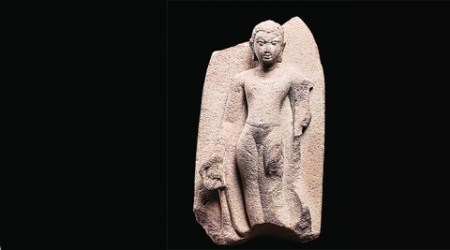Stay updated with the latest - Click here to follow us on Instagram
In Good Faith
An exhibition in New York explores the sculptural art produced in the earliest kingdoms of Southeast Asia.
 Dressed in a diaphanous robe, the calm sandstone Buddha has survived numerous centuries and also travelled numerous countries.
Dressed in a diaphanous robe, the calm sandstone Buddha has survived numerous centuries and also travelled numerous countries.
Dressed in a diaphanous robe, the calm sandstone Buddha has survived numerous centuries and also travelled numerous countries. Carved in Sarnath sometime in the beginning of the sixth century, it is a diminutive six-and-a-half inch tall sculpture. The flexed posture and characteristic fine-grained sandstone affirm its origin. In the collection of National Museum, Bangkok, it was possibly commissioned for export, perhaps by a monk returning to his monastery after a period of study in northern India.
After all, Buddhism in that period left its imprint across Southeast Asia, much like Hinduism. An exhibition at the Museum of Modern Art, New York, called “Lost Kingdoms Hindu-Buddhist Sculpture of Early Southeast Asia, 5th to 8th Century” is now exploring sculptural art produced in the earliest kingdoms of Southeast Asia. “From the first millennium onward, powerful kingdoms emerged in the region, embracing much of Indic culture to give political and religious expression to their identities. Hinduism (Brahmanism) and Buddhism arrived early, first witnessed by Sanskrit inscriptions, and shortly thereafter by a proliferation of large-scale religious imagery,” states a museum note on the
exhibition, which started last month.
The display comprises over 160 sculptures, associated with the identifiable cultures of Pyu, Funan, Zhenla, Champa, Dvaravati, Kedah and Srivijaya. “These are the ‘lost kingdoms’, whose identities and sometimes very existence only emerged from the historical shadows in the twentieth century, as a result of pioneering epigraphic and archaeological research”.
Borrowed from museums across the world — Cambodia, Vietnam, Thailand, Malaysia, Singapore, Myanmar, and Paris among others — the Buddha from Sarnath is only one of the highlights. There is also a late 6th century bronze icon of Avalokiteshvara. Excavated in peninsular Thailand in 1961, it reminds one of the late Amaravati style of southern India. In a 7th-8th century Vietnam sandstone, Ganesha is represented as an ascetic, with a third eye on his forehead and wearing the tiger skin like his father.
There are also avatars of Hindu gods rarely seen in India. Coming from south Cambodia is a sandstone Kalkin. With a horse-head, this is understood as the tenth avatar of Vishnu, who will appear in the form of a white horse to judge mankind. The tale of Krishna lifting Mount Govardhan, as described in the Bhagavata Purana, is depicted in a 7th century south Cambodian sandstone. “Exhibitions that provide this level of exposure to previously unfamiliar material of such significance come along very rarely,” notes Thomas P Campbell, Director and CEO of the Metropolitan Museum, New York. The exhibition closes in July.
vandana.kalra@expressindia.com







